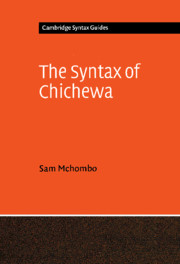Book contents
- Frontmatter
- Contents
- Acknowledgments
- List of abbreviations
- 1 Introduction
- 2 Phonetics and phonology
- 3 Clause structure
- 4 Relative clauses, clefts, and question formation
- 5 Argument structure and verb-stem morphology
- 6 Argument-structure-reducing suffixes
- 7 The verb stem as a domain of linguistic processes
- References
- Index
5 - Argument structure and verb-stem morphology
Published online by Cambridge University Press: 08 October 2009
- Frontmatter
- Contents
- Acknowledgments
- List of abbreviations
- 1 Introduction
- 2 Phonetics and phonology
- 3 Clause structure
- 4 Relative clauses, clefts, and question formation
- 5 Argument structure and verb-stem morphology
- 6 Argument-structure-reducing suffixes
- 7 The verb stem as a domain of linguistic processes
- References
- Index
Summary
Introductory remarks
In the previous chapters the discussion centered round aspects of clause structure and the morphological elements that appear prefixed to the verb stem in Chichewa. Those elements are more oriented towards aspects of clause structure. It has been argued that they are best analyzed as clitics, since they are syntactic elements that happen to be phonologically bound (cf. Mchombo 2002a). The arguments for analyzing them as clitics will be reviewed below. Clitics are formally and functionally different from the affixes that are suffixed to the verb root. These include affixes that encode passivization, causativization, applicativization, as well as affixes that derive verbs with stative reading and reciprocal verbs. These affixes are traditionally known as extensions. The verbal extensions are functionally different from the clitics in that they affect the number of expressible NPs that the predicate can support. In brief, they are involved in transitivity patterns. They are formally different in that they do not conform to the basic syllable structure of the language. They have a -VC- syllable organization where the language normally requires CV syllable structure. The involvement of verbal extensions in argument structure will be the focus of this chapter.
The structure of the verb
The verb in Chichewa (and other Bantu languages) is traditionally analyzed as comprising a verb root (VR) to which such verbal extensions as the causative, applicative, reciprocal, passive, etc., are suffixed, and to which prefixes are added. The latter encode information pertaining to agreement with the subject and object(s) of the verb, tense/aspect, negation, modality, etc.
Information
- Type
- Chapter
- Information
- The Syntax of Chichewa , pp. 63 - 89Publisher: Cambridge University PressPrint publication year: 2004
